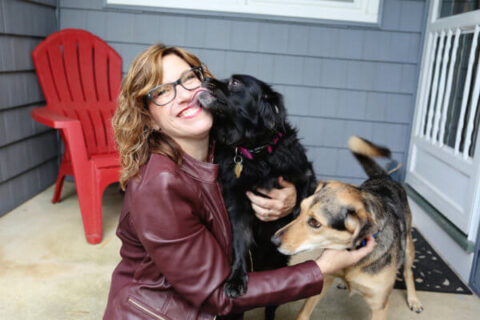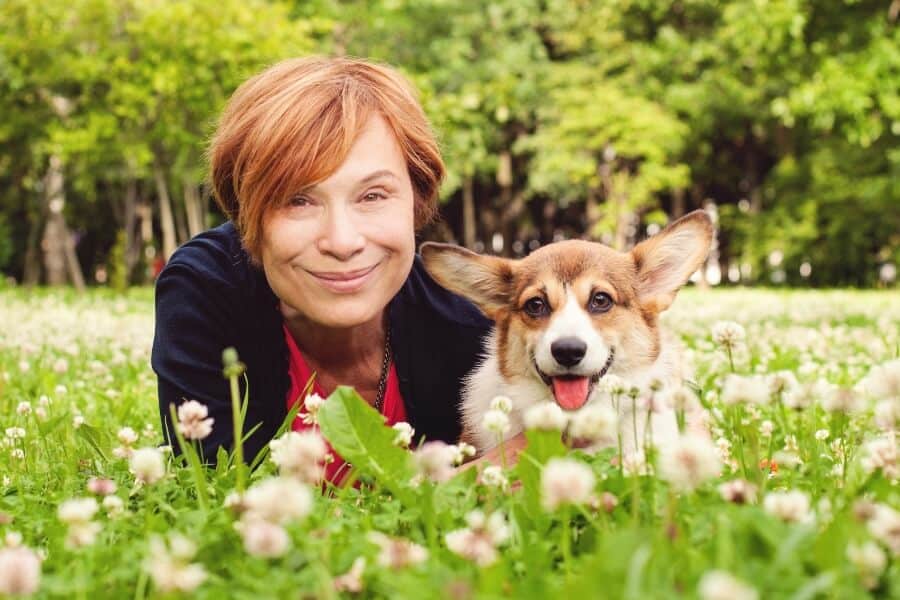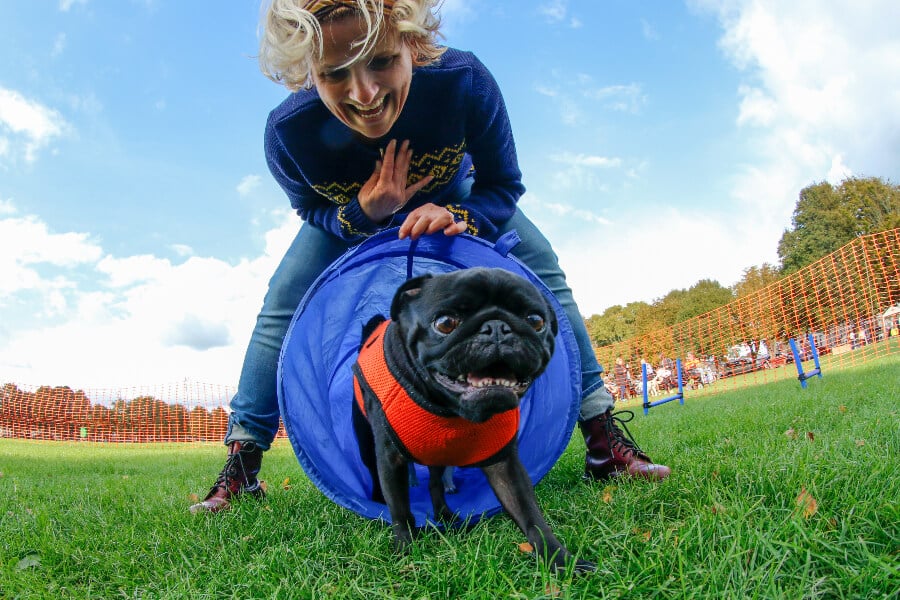Here’s the question I got nearly every time I walked my mutt Buffy around town: “What kind of dog is that?” When we adopted him, the shelter listed him as a Golden Retriever, Cocker Spaniel, and Beagle mix, but all we knew for sure is that he acted like a perennial puppy and looked like a Golden who had spent too much time in the dryer and then lost half of his tail.
He looked like a Golden Retriever that had spent too much time in the dryer and then lost half of his tail.
At 39 pounds and about two feet tall, he was the size of a Spaniel with the face of both a Golden and Cocker. The Beagle part in him came out whenever police or fire engine sirens were nearby—he would stand in the backyard and howl.
Doggie DNA tests didn’t exist when we adopted him, at age four, in 2002. And by the time he died, just shy of 16 in 2013, we didn’t care what kind of dog Buffy was. He had been a great dog for our family.
Read More: The Healing Power of Dogs: One Writer Gets the Pet She Needed, but Never Wanted
The Next Round
After Buffy died, we adopted our next dog pretty quickly. Actually, my daughters browbeat me into adopting two puppies. Why in the world I agreed to go back to potty training with not one but two puppies, I have no idea. I was not a happy camper.
We grew tired of explaining what we thought the dogs were. And we were curious.
But the dogs were adorable. Gable, we were told, was a Dachshund and Golden Retriever mix. With shorter-than-average legs, a golden color, and a long fluffy tail, we could definitely see the Golden in him—even if he never weighed more than 25 pounds. Sadie, we were told, was a Black Lab and Spaniel cross.
Both seemed like benign mixed breeds, but we grew tired of having to explain what we thought the dogs were in response to friends’ and passers-by’s questions. And we were curious.
So we splurged and got two doggie DNA kits.
Getting to the Cellular Level

Mystery pups no longer. Leah with Sadie and Oscar.
That’s right: A doggie DNA test takes the genetic material you’ve submitted from your dog and looks for common traits that it links to breeds. Don’t worry, that genetic material collection doesn’t hurt your pup or involve having to collect anything scatological. Rather, you take a mascara wand-like brush and run it along the inside of your dog’s cheeks. Note: Doing this is about as fun as trying to brush your dog’s teeth—in other words, not very. You mail this sample to the company, and about six to eight weeks later an email arrives, letting you know that your DNA results are ready to be read online.
Right now there are three major companies offering doggie DNA testing. They are Wisdom Pane, DNA My Dog, and Embark. Prices range from $70 to almost $200 for a kit; we went with the Wisdom Panel ones for about $100 each on Amazon. In many instances, these tests are really just a guess based on the probability of a breed because of genetic markers they found. Then again that’s probably how my own Ancestry DNA test worked. (Who knew I was Irish?)
The Big Reveal
When the dogs’ DNA results came back a couple of months later, we were shocked and disappointed.
Once we had her heritage information and looked at Sadie pretty closely, some of her distinct features started to make sense.
Let me start with the DNA results that shocked us—Sadie’s. Her greatest percentage of pure-breed heritage was Redbone Coonhound. We had to Google “Redbone Coonhound,” having never seen one in real life. They’re Southern dogs. We grew up in the Northeast. But the next likely breed of her parents? A Pekingese mix. All my husband Bill and I could think was, How did that mating work? Redbone Coonhounds are big dogs. Pekingese are not. TMI, for sure.
Once we had her heritage information and looked at Sadie pretty closely, some of her distinct features started to make sense. While she doesn’t have the flatter face of a Pekingese, her eyes and nose are smaller and her head rounder than you might expect from a Spaniel or a Lab. The Redbone Coonhound shows through in the cutest way, asbest described by a little girl we once met on the street: “You dog’s ears look like they were dipped in chocolate.”
Yup. Behind Sadie’s ears are brownish-red waves of fur. It’s the same with the tufts of fur between her toes. Well, at least it was when she was a pup. Now a stately four years old, the chocolate has turned to a silvery grey.
So in Sadie’s case, finding out this kooky combination of breeds was fun, educational, and even amusing.
With Gable, not so much.
Our “No Shit, Sherlock” Results
Gable’s DNA results were simply boring. Golden Retriever mix. That was all it said. And I paid $100 for that? I could have told you he had Golden Retriever in him. Any kid on the street probably could have, too. But where was the Dachshund? Or the Corgi? Or another breed that would explain why he had notably short legs and was so small?
They said 50 percent of Gable’s genetic profile was too mixed to detect a dominant purebred dog within the last three generations.
I actually sent Wisdom Panel a letter of complaint. Here’s what they sent back to me: “[O]nly around 50 percent of Gable’s genetic profile was detectable, leaving 50 percent too mixed to detect a dominant purebred dog within the last three generations.”
They then asked me to send pictures of him so they might point out the dominant features of the Golden retriever, the only breed that showed up in his profile. They noted that the feathering on his tail and behind his ears as well as his coat color all pointed to the Golden. But he was so Heinz 57 that the rest of him was a big old question mark.
Getting More Insight
Wisdom Panel also said something interesting in response to my query about Gable’s leg stature, which the rescue had included in his Petfinder profile:
“Unfortunately, what a dog ‘looks’ like is not always what a dog appears to be. Research using shelter personnel has shown that visual identification of a mixed-breed dog’s ancestry was only accurate approximately 25 percent of the time—in other words, 75 percent of the time, they could not even identify a single correct breed in the dog’s ancestry and furthermore, 87.5 percent of the time, their ‘guesses’ were incorrect (sometimes they called more than one breed in a dog, hence the difference in the numbers).”
Research has shown that when shelter personnel makes a visual identification of a mixed-breed dog’s ancestry, they’re only accurate approximately 25 percent of the time.
All the more reason, I guess, to do a DNA test on a rescue dog and try to get a little more insight. Some DNA testing kits—both human and canine—claim that they can identify potential health conditions. Unfortunately, we did not get any such useful information from our results. I was hoping for a better understanding of Gable; we adopted him when he was younger than six months old. By the time he was one, he started exhibiting signs of fear aggression. We had started working with trainers so we could learn how to be responsible owners of a dog with this condition, but a few months later, he escaped from our dog sitter’s home, was hit by a car, and killed.
What About Oscar?
Sadie was despondent without her brother, so soon we soon adopted Oscar. The rescue told us he was a Catahoula Leopard dog (back to Google we went to figure out what the hell a Catahoula was), but we decided to get more info and did the DNA test one more time, even though Gable’s hadn’t been a home run.
To be honest, with his curly tail like a question mark, I was concerned he would come back having Chow in him. I know that Chows are biters, and after Gable, we were worried about having another aggressive dog. Also, Chow ancestry could affect our homeowner’s insurance, meaning, we might have to pay more if we had what was considered to be a dangerous dog.
Deep down, we felt the chances of this were pretty small. Oscar is the polar opposite of Gable—if you raise your voice around Oscar, he will roll over and pee himself!
Not only did Oscar’s DNA come back without Chow (whew!) but also without Catahoula.
To be honest, with his curly tail like a question mark, I was concerned he would come back having Chow in him.
Another rescue guess gone completely off-track. In fact, Oscar is 65 percent mixed breed of unknown origin, but Wisdom Panel was nice enough to include a list of about 50 breeds he could be mixed with. The most dominant breed to show up for him? Australian Shepherd, which makes total sense. His dominant color is a grey-black brindle.
My husband jokes that spending $100 on a doggie DNA kit shows we have too much disposable income. Maybe it does. Is it worth the money? Maybe yes, maybe no. But at least now, when I walk Sadie and Oscar around town and someone asks, “What kind of dog is that?” I can answer with a degree of certainty.
Read More: The Other Female in Our Bed—And Why I Welcomed Her
Writer Leah Ingram’s love for dogs inspired her to launch Puppieware, an online store that sells dog shaped cake pans and bakeware, dog bone birthday candles, and gifts for dog lovers.
A version of this story was originally published in March 2018.





















0 Comments